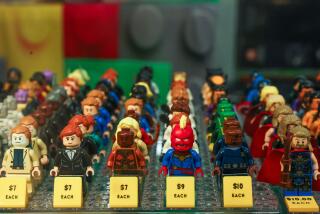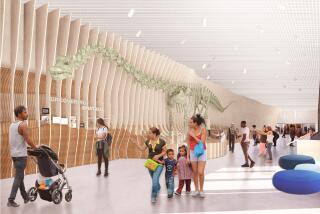For the Dinosaur Lover on Your List
Mary Odana’s studio in Chatsworth is littered with dinosaur parts. A Triceratops head lies in one corner. The skull of a Tyrannosaurus Rex rests against a wall.
But it’s the rubbery, orange Velociraptor in the center of the room that is most remarkable. The roboticized replica of the dinosaur, which made its debut in the 1993 film “Jurassic Park,” not only moves its head, raises its arm and opens its jaws--it’s for sale.
The 5-foot-tall, 14-foot-long creature is one of eight types of dinosaur that are being built on demand and made available to individuals for the first time.
“We decided it would be great to announce it in time for Christmas, but really at any time of year people could enjoy these as giant coat racks,” said “Dino Don” Lessem, a self-confessed dinosaur fanatic and author who served as a consultant on the “Jurassic Park” films. Lessem has contracted with Odana’s firm, Valley Anatomical, to make the replicas and is selling them on his Web site, https://www.dinodon.com.
The dinosaurs range in size from 2 to 47 feet in length and cost between $2,000 and $350,000. The Dilophosaurus, or “Spitter,” as Lessem calls it, costs $35,000. The roboticized model, which can fan its neck, shake its head and spit, costs double.
A full-size T. Rex is 47 feet long and costs $350,000. If that’s too expensive, the 6-foot-long head can be purchased on its own for $40,000.
The models are based on molds created by the Academy Award-winning Stan Winston design studio, which also designed the monsters for the “Aliens” and “Terminator” films. Lessem’s company, Dinosaur Productions in Boston, owns the molds in conjunction with Universal Studios and Amblin Entertainment.
“When the first ‘Jurassic Park’ movie was finished shooting, I asked [Steven] Spielberg if I could have the stuff left over from the movie, and he said sure,” Lessem said.
He contracted with Odana, whom he met at a Society of Vertebrate Paleontologists gathering, to help re-create the replicas for a traveling museum exhibit called “The Dinosaurs of Jurassic Park.” The exhibit raised $1.5 million--all of which went to the Jurassic Foundation, a nonprofit organization Lessem co-founded two years ago to provide paleontologists with grant money for dinosaur research. A percentage of the replicas’ sales to individuals will also be donated to the foundation, he said.
Since the exhibit, Lessem has worked with Odana to make several more replicas. Odana uses hard molds to make the replicas, but the dinosaurs themselves are soft to the touch since they are made from silicone and latex. “They feel like a real animal,” Odana said. “Creepy, huh?”
One of the replicas is on display at the L.A. County Museum, where Odana used to work preparing fossil skulls. A Japanese amusement park also owns one.
A former Microsoft executive and friend of Spielberg’s owns five. He is rumored to keep them in his garden and so far is the only private individual to own them.
Lessem hopes to change that. “It’s the ultimate Christmas gift for the big boys who like expensive toys,” he said.
Odana agrees that the replicas are the ultimate gift. “But I’m not sure we can get [them] ready by the 25th,” she said. “Maybe by the 27th.”
More to Read
The biggest entertainment stories
Get our big stories about Hollywood, film, television, music, arts, culture and more right in your inbox as soon as they publish.
You may occasionally receive promotional content from the Los Angeles Times.










